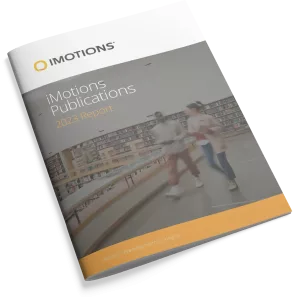-
Emotion Detection on User Front-Facing App Interfaces for Enhanced Schedule Optimization: A Machine Learning Approach
Human-Computer Interaction (HCI) has evolved significantly to incorporate emotion recognition capabilities, creating unprecedented opportunities for adaptive and personalized user experiences. This paper explores the integration of emotion detection into calendar applications, enabling user interfaces to dynamically respond to users’ emotional states and stress levels, thereby enhancing both productivity and engagement. We present and evaluate two […] -
An Eye Tracking Study on the Effects of Dark and Light Themes on User Performance and Workload
The visual theme of a dashboard, whether light or dark, is a prominent design choice with potential implications for user experience. This research investigates the effect of visual theme on user performance and workload during decision-making tasks on dashboards. In a within-subjects experiment, we measured the effect of dark and light themes and task complexity […] -
Biometrics in roadway design: incorporating the subliminal human experience
Numerous tools are available to transportation planners and designers to understand how people use and navigate roadways while driving. Innovations in biometric technology present new methods to tap collective wisdom and measure visual attention and emotion elicited by urban elements, like streets. Photos and videos were collected during Memorial Drive’s seasonal road closure in Cambridge, […] -
Monitoring Viewer Attention During Online Ads
Nowadays, video ads spread through numerous online platforms, and are being watched by millions of viewers worldwide. Big brands gauge the liking and purchase intent of their new ads, by analyzing the facial responses of viewers recruited online to watch the ads from home or work. Although this approach captures naturalistic responses, it is susceptible […] -
The Role of Empathy in Leadership Ethics: Examining Empathic Relational Leadership Practice through Video-Based Methods
Using a relational leadership lens, this study aims to gain a deeper understanding of empathic conversations with a focus on leadership ethics. It adopts an entitative perspective in relational leadership and examines leadership conversations as a two-way influence relationship, highlighting their interdependencies and collective role in the co-construction of meaning. Data from facial expression software […] -
Emotional contagion in dyadic online video conferences—empirical evidence based on self-report and facial expression data
Introduction: Emotional contagion is an essential and prevalent emotional process in social interaction and comprises the transmission of emotions between two or more individuals. The vast majoriy of prior research explored the emotional contagion in face-to-face human interaction. The present study explored the degree to which emotional contagion occurs in dyadic online video conferences, using subjective […] -
An Eye-Tracking Study on Text Comprehension While Listening to Music: Preliminary Results
The aim of the present study was to examine the effect of background music on text comprehension using eye-tracking technology. Ten Greek undergraduate students read four texts under the following four reading conditions: preferred music, non-preferred music, café noise, and in silence. Eye movements were tracked to assess visual patterns, while reading performance and attitudes […] -
A Multisensor Dataset of South Asian Post-Graduate Students Working on Mental Rotation Tasks
Spatial thinking, in general, and mental rotation, in particular, have seen sustained research attention due to such abilities playing a critical role in STEM (science, technology, engineering and mathematics) learning. The recent development of sensor-based approaches to identify, understand, and measure cognition and affect opens up new possibilities to study such topics. We collected galvanic […] -
Physiological measurement techniques in virtual tourism research: three caveats for future studies
Research on virtual tourism is receiving substantial scholarly attention. Existing studies on virtual tourism tend to apply self-report methods to assess user experiences, overlooking the potential of physiological measurement techniques. Empirical work in conceptually related areas, contends physiological methods have a demonstrated capacity to unearth unconscious mental processes, which can help mitigate potential cognitive biases […] -
Assessing ECG Interpretation Expertise in Medical Practitioners Through Eye Movement Data and Neuromorphic Models
This study introduces an innovative method for assessing ECG interpretation abilities in medical professionals via eye-tracking data. We examine eye movement patterns from five separate groups of cardiology practitioners utilizing a combination of neuromorphic computing models, including Spiking Neural Networks (SNN), Spiking Convolutional Neural Networks (SCNN), Recurrent Spiking Neural Networks (RSNN), and Spiking Convolutional Long […]
Research Report 2024
In-depth look at the scientific landscape as powered by iMotions software, showcasing groundbreaking research and the impact of our tools in various scientific and industrial fields.

iMotions Science Resources
Looking for white papers, validation reports or research show casing iMotions Multimodal capabilities?
Share Your Research

850+ universities worldwide with an iMotions human behavior lab
73 of the top 100 highest ranked universities
710+ published research papers using iMotions
iMotions is used for some of the most interesting human behavior research studies carried out by top researchers around the world. Contact us to have your publication featured here.
The authors of these publications have used iMotions as a software tool within their research.
“Software should be cited on the same basis as any other research product such as a paper or a book; that is, authors should cite the appropriate set of software products just as they cite the appropriate set of papers” (Katz et al., 2020).
We therefore encourage you to cite the use of iMotions where appropriate.
How to cite iMotions
APA
iMotions (10), iMotions A/S, Copenhagen, Denmark, (2024).
Note: adjust the version and year where relevant.
5 Most Popular Blogs
Learn How to Conduct Human Behavior Research with iMotions
Publications
Read publications made possible with iMotions
Blog
Get inspired and learn more from our expert content writers
Newsletter
A monthly close up of latest product and research news



